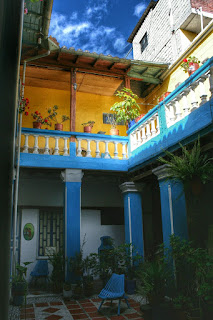We quietly ate some pastries we had picked up and pretended not to be British, until it was time board the LAN flight to Lima. On the aircraft, we were treated to some chirpy 'elevator-style' bossa nova, until we took off and got an eyeful of the wrinkly ground surrounding Cusco, small white lines zig-zagging over its surface denoting paths to remote hilltop locations.
Lima, where military parades for the fiestas patrias were taking place, was covered in a grey pall of cloud. The view in, unlike the splendid aerial vista of Cusco, showed little to recommend the city. We spent what little time we had between flights relaxing in the airport's Sumaq lounge, where we enjoyed a pisco sour from the bar - it was 10:30am but the last opportunity for a genuine Peruvian cocktail - an orange juicing machine, and a coffee maker that played a blast of music every time it dispensed a cup and serenaded me with a snippet of Mas Que Nada while it vended a cappuccino. With such a wealth of drinks from which to choose, I happily bypassed the Inca Kola, which I had tried preciously, and which is apparently flavoured with lemongrass, but instead looks and tastes like diabetic's urine.
 |
| Inca Kola |
To complement the liquid servings, a selection of salad ingredients was laid out, with no appearance from the classic 'salad trinity', lettuce, tomato, and cucumber - why do we in Britain think these are required features of a salad? - and a healthy(!) selection of cakes, which more than made up for the desultory sandwich offered onboard the onward Quito-bound flight with LAN, which of course turned out to contain chicken.
After the two hops, we arrived in Quito airport. Not quite so conveniently situated - the old airport within the city is now a park - we organised to be met by our young host, Alejandro, to take us to our accommodation, the Blue Door. Once again, we found ourselves on top of a hill, this time in Quito's San Juan district. Although only 2,900m elevation - contrast Cusco's 3,400m - we still had a good view over the town in a pleasant neighbourhood near a stunning basilica. The house itself is a collection of rooms facing onto an open courtyard, much as a Moroccan-style riad.
 |
| Blue Door |
Having arrived close to evening, we settled only briefly before exiting and navigating our way to La Mariscal area of town, which is replete with restaurants but also tourists. Hoping for a tofu and SE Asian fix, we went straight to Uncle Ho's, whose walls are plastered with pictures of the venerated Vietnamese leader. The menu presented an unprepossessing mix of Ecuadorian, Thai, and Vietnamese cuisine, but an initial cà phê sữa đá (iced coffee) was surprisingly authentic, albeit less strong than we had tasted on the other side of the planet. Summer rolls were familiar, even if the peanut sauce lacked any kind if spice. In fact, the quintessential Thai spice and Vietnamese flavour was largely absent from the tofu green curry (which came with some incongruous Mediterranean vegetables) and a weird tofu and mushroom skewer braised in a soy-based sauce, which were both relatively bland. I suppose it is unfair to expect authentic cuisine outside of the country of origin, and Uncle Ho's presented a frankly unexciting fusion of Asian and Latin American flavours.
 |
| Vietnamese food, Ecuador style |
Despite being a capital city, Quito feels relatively safe, so we decided to make the return journey on foot. This would have been fine, apart from an unnecessary detour onto Av. 6 Deciembre*, which precipitated a close encounter with a large man kicking off in a local café and turning over the counter in spectacular, if fearsome, style. This was an inauspicious introduction to Quito and we quickened our pace home after that with mixed emotions about leaving the safe haven of Cusco for the (apparently) mean streets of Quito.
* The street names of Quito are, like many places in South America, a mixture of place names (Venezuela, Uruguay, Mexico, Canada), historical dates (9th October, 10th August, 6th December, 12th October) and important figures (José Mejía, José Olmeda, José Sucre, Juan Montúfar, Juan Larrea**).
** It's odd just how many people are called either Juan or José - one chap (fittingly the first president of Ecuador) even managed a double whammy with Juan José Flores.
No comments:
Post a Comment